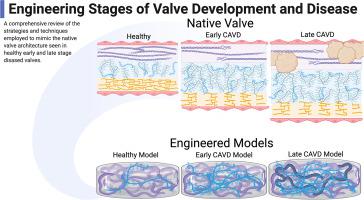Journal of Molecular and Cellular Cardiology ( IF 4.9 ) Pub Date : 2021-07-30 , DOI: 10.1016/j.yjmcc.2021.07.009 Ashley J Scott 1 , LaTonya R Simon 2 , Heather N Hutson 2 , Ana M Porras 2 , Kristyn S Masters 3

|
For such a thin tissue, the aortic valve possesses an exquisitely complex, multi-layered extracellular matrix (ECM), and disruptions to this structure constitute one of the earliest hallmarks of fibrocalcific aortic valve disease (CAVD). The native valve structure provides a challenging target for engineers to mimic, but the development of advanced, ECM-based scaffolds may enable mechanistic and therapeutic discoveries that are not feasible in other culture or in vivo platforms. This review first discusses the ECM changes that occur during heart valve development, normal aging, onset of early-stage disease, and progression to late-stage disease. We then provide an overview of the bottom-up tissue engineering strategies that have been used to mimic the valvular ECM, and opportunities for advancement in these areas.
中文翻译:

通过发育、衰老和疾病阶段设计主动脉瓣细胞外基质
对于如此薄的组织,主动脉瓣具有极其复杂的多层细胞外基质 (ECM),而这种结构的破坏构成了纤维钙化主动脉瓣疾病 (CAVD) 的最早标志之一。天然瓣膜结构为工程师模仿提供了一个具有挑战性的目标,但基于 ECM 的先进支架的开发可能会实现在其他培养或体内平台中不可行的机制和治疗发现。这篇综述首先讨论了心脏瓣膜发育、正常衰老、早期疾病发作和晚期疾病进展过程中发生的 ECM 变化。然后,我们概述了用于模拟瓣膜 ECM 的自下而上的组织工程策略,以及在这些领域取得进展的机会。











































 京公网安备 11010802027423号
京公网安备 11010802027423号